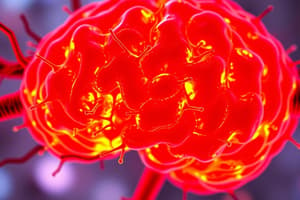Podcast
Questions and Answers
What do polysynaptic reflexes produce?
What do polysynaptic reflexes produce?
- EPSPs
- IPSPs
- Both EPSPs and IPSPs (correct)
- None of the above
What is the role of the tendon reflex?
What is the role of the tendon reflex?
Monitors external tension produced during muscle contraction and prevents the contracting muscle from developing too much tension or tearing tendons.
The Golgi tendon organ structure is located where _____ meets muscle.
The Golgi tendon organ structure is located where _____ meets muscle.
tendon
How does the tendon reflex organization work?
How does the tendon reflex organization work?
Tendon reflexes are only modulated by muscle activity.
Tendon reflexes are only modulated by muscle activity.
What does the flexor reflex do?
What does the flexor reflex do?
What is reciprocal inhibition related to?
What is reciprocal inhibition related to?
Ipsilateral reflex arcs include _____, tendon, and withdrawal reflexes.
Ipsilateral reflex arcs include _____, tendon, and withdrawal reflexes.
What is the function of crossed extensor reflexes?
What is the function of crossed extensor reflexes?
What type of circuit is a reverberating circuit?
What type of circuit is a reverberating circuit?
List one general characteristic of polysynaptic reflexes.
List one general characteristic of polysynaptic reflexes.
How does the brain influence spinal reflexes?
How does the brain influence spinal reflexes?
Upper centres in the brain have no effect on reflexes involved in walking.
Upper centres in the brain have no effect on reflexes involved in walking.
What happens during the reinforcement of spinal reflexes?
What happens during the reinforcement of spinal reflexes?
What is the result of inhibition of spinal reflexes?
What is the result of inhibition of spinal reflexes?
Flashcards are hidden until you start studying
Study Notes
Polysynaptic Reflexes
- Involve interneurons that produce either excitatory (EPSPs) or inhibitory (IPSPs) postsynaptic potentials.
Tendon Reflex
- Monitors external tension during muscle contraction to prevent excessive tension and protect tendons from damage.
Golgi Tendon Organ
- Located where tendons meet muscles, made of collagen fibers surrounding 1b afferent endings.
- Activation occurs as collagen fibers squeeze during muscle contraction, triggering afferent signals.
Tendon Reflex Organization
- 1b afferents synapse with interneurons responsible for inhibiting agonist α motor neurons and exciting antagonist α motor neurons via K channel modulation.
Modulation of Tendon Reflex
- Influenced by various inputs including joint receptors and cutaneous receptors, alongside descending pathways.
Flexor Reflex
- Facilitates withdrawal of body parts from painful or pressurized stimuli; response strength is determined by stimulus intensity and location.
Reciprocal Inhibition
- Involves inhibition of antagonist muscle contraction, critical for flexor reflexes and a general trait of polysynaptic reflexes, which can be intersegmental.
Ipsilateral Reflex Arc
- Consists of stretch, tendon, and withdrawal reflexes, activating muscles on the same side of the body.
Crossed Extensor Reflex
- Contralateral reflex arc that contracts extensor muscles; example includes extending the opposite leg when standing on a pin for weight distribution.
- Maintained through reverberating circuits.
Reverberating Circuit
- Functions as a positive feedback loop that prolongs reflexive motor responses.
General Characteristics of Polysynaptic Reflexes
- Involve multiple neuron pools which are intersegmental.
- Include reciprocal inhibition and reverberating circuits.
- Numerous reflexes work together for coordinated responses.
Integration and Control of Spinal Reflexes
- Though reflexes are automatic, processing centers in the brain can modulate these reflexes by facilitating or inhibiting spinal patterns.
Facilitation of Reflexes by Upper Centers
- Upper centers activate reflexes relevant for activities such as walking and chewing.
Reinforcement of Spinal Reflexes
- Higher brain centers stimulate excitatory neurons in the brain stem or spinal cord to create EPSPs, thereby enhancing reflex motor neurons' activity.
Inhibition of Spinal Reflexes
- Higher centers can also stimulate inhibitory neurons, leading to IPSPs that suppress reflex motor neuron activity.
Studying That Suits You
Use AI to generate personalized quizzes and flashcards to suit your learning preferences.




